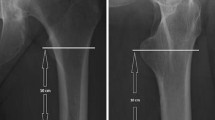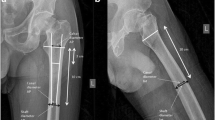Abstract
Introduction
Postoperative complications after hip fractures in osteoporotic bone such as implant cutout can be reduced by the use of specially designed implants or additional cement augmentation. It is not yet clear at which degree of osteoporosis, patients will profit from implant augmentation or specially designed implants for geriatric patients. As the surgeon ideally should obtain information on local bone quality at the site of implant anchorage already preoperatively, the aim of the study was to develop an easily applicable radiographic method to estimate bone quality in those patients.
Materials and methods
75 patients with unilateral hip fracture were included. Preoperatively, a CT scan with a calibration device was conducted. Postoperatively, DXA scans were performed. The proposed method measures local cancellous bone mineral density in the contralateral and uninjured femoral head. As a control, 15 young and healthy non-osteoporotic subjects were included. Inter- and intraobserver reliability was investigated for a subgroup of 20 patients.
Results
Study group patients had a mean BMD measured by CT scans of 194.2 mg/cm3 (SD 40.4). There was a statistically significant correlation with data from DXA scans (r = 0.706, p < 0.001). The control group was significantly younger and showed a significantly higher BMD when compared to the study group (p < 0.001). Reliability evaluation showed no statistically significant difference in inter- and intraobserver measurements. Interclass correlation proved to be very high.
Conclusion
The proposed method is an easily applicable, reliable and useful tool to estimate bone quality preoperatively using the contralateral hip as a reference. Obtained data may facilitate the decision-making towards the use of further therapeutic measures to improve implant anchorage in osteoporotic bone such as bone cement augmentation. Thus, our method allows for a more individualized surgical treatment of hip fracture patients adapted to the estimated cancellous bone quality of the patient.





Similar content being viewed by others
References
Baumgaertner MR, Curtin SL, Lindskog DM, Keggi JM (1995) The value of the tip-apex distance in predicting failure of fixation of peritrochanteric fractures of the hip. J Bone Joint Surg Am 77(7):1058–1064
Bonnaire F, Zenker H, Lill C, Weber AT, Linke B (2005) Treatment strategies for proximal femur fractures in osteoporotic patients. Osteoporos Int 16(Suppl 2):S93–S102
Bousson V, Le Bras A, Roqueplan F et al (2006) Volumetric quantitative computed tomography of the proximal femur: relationships linking geometric and densitometric variables to bone strength. Role for compact bone. Osteoporos Int 17(6):855–864
de Klerk G, van der Velde D, van der Palen J, van Bergeijk L, Hegeman JH (2009) The usefulness of dual energy X-ray and laser absorptiometry of the calcaneus versus dual energy X-ray absorptiometry of hip and spine in diagnosing manifest osteoporosis. Arch Orthop Trauma Surg 129(2):251–257
Erhart S, Schmoelz W, Blauth M, Lenich A (2011) Biomechanical effect of bone cement augmentation on rotational stability and pull-out strength of the Proximal Femur Nail Antirotation. Injury 42(11):1322–1327
Fogagnolo F, Kfuri M Jr, Paccola CA (2004) Intramedullary fixation of pertrochanteric hip fractures with the short AO-ASIF proximal femoral nail. Arch Orthop Trauma Surg 124(1):31–37
Haiat G, Padilla F, Barkmann R et al (2005) Optimal prediction of bone mineral density with ultrasonic measurements in excised human femur. Calcif Tissue Int 77(3):186–192
Hauschild O, Ghanem N, Oberst M et al (2009) Evaluation of Singh index for assessment of osteoporosis using digital radiography. Eur J Radiol 71(1):152–158
Huber MB, Carballido-Gamio J, Bauer JS et al (2008) Proximal femur specimens: automated 3D trabecular bone mineral density analysis at multidetector CT—correlation with biomechanical strength measurement. Radiology 247(2):472–481
Kammerlander C, Gebhard F, Meier C et al (2011) Standardised cement augmentation of the PFNA using a perforated blade: a new technique and preliminary clinical results. A prospective multicentre trial. Injury 42:1484–1490
Khoo BC, Brown K, Cann C et al (2009) Comparison of QCT-derived and DXA-derived areal bone mineral density and T scores. Osteoporosis international : a journal established as result of cooperation between the European Foundation for Osteoporosis and the National Osteoporosis Foundation of the USA 20(9):1539–1545
Koot VC, Kesselaer SM, Clevers GJ, de Hooge P, Weits T, van der Werken C (1996) Evaluation of the Singh index for measuring osteoporosis. J Bone Joint Surg Br 78(5):831–834
Krappinger D, Bizzotto N, Riedmann S, Kammerlander C, Hengg C, Kralinger FS (2011) Predicting failure after surgical fixation of proximal humerus fractures. Injury 42(11):1283–1288
Krappinger D, Roth T, Gschwentner M et al (2011) Preoperative assessment of the cancellous bone mineral density of the proximal humerus using CT data. Skeletal Radiol 41:299–304
Lenich A, Mayr E, Ruter A, Mockl C, Fuchtmeier B (2006) First results with the trochanter fixation nail (TFN): a report on 120 cases. Arch Orthop Trauma Surg 126(10):706–712
Lips P (1997) Epidemiology and predictors of fractures associated with osteoporosis. Am J Med 103(2A):3S–8S (discussion 8S–11S)
Liu XS, Cohen A, Shane E et al (2010) Bone density, geometry, microstructure, and stiffness: relationships between peripheral and central skeletal sites assessed by DXA, HR-pQCT, and cQCT in premenopausal women. J Bone Miner Res 25(10):2229–2238
Lotz JC, Gerhart TN, Hayes WC (1990) Mechanical properties of trabecular bone from the proximal femur: a quantitative CT study. J Comput Assist Tomogr 14(1):107–114
Mereddy P, Kamath S, Ramakrishnan M, Malik H, Donnachie N (2009) The AO/ASIF proximal femoral nail antirotation (PFNA): a new design for the treatment of unstable proximal femoral fractures. Injury 40(4):428–432
O’Neill F, Condon F, McGloughlin T, Lenehan B, Coffey JC, Walsh M (2011) Dynamic hip screw versus DHS blade: a biomechanical comparison of the fixation achieved by each implant in bone. J Bone Joint Surg Br 93(5):616–621
Ramamurthi K, Ahmad O, Engelke K et al (2012) An in vivo comparison of hip structure analysis (HSA) with measurements obtained by QCT. Osteoporos Int 23(2):543–551
Reilly K, Munro J, Pandit S, Kress A, Walker C, Pitto RP (2007) Inter-observer validation study of quantitative CT-osteodensitometry in total knee arthroplasty. Arch Orthop Trauma Surg 127(8):729–731
Sermon A, Boner V, Boger A et al (2011) Potential of polymethylmethacrylate cement-augmented helical proximal femoral nail antirotation blades to improve implant stability—a biomechanical investigation in human cadaveric femoral heads. J Trauma Acute Care Surg 72:E54–E59
Sermon A, Boner V, Schwieger K et al (2011) Biomechanical evaluation of bone-cement augmented Proximal Femoral Nail Antirotation blades in a polyurethane foam model with low density. Clin Biomech (Bristol, Avon) 27:71–76
Simmermacher RK, Bosch AM, Van der Werken C (1999) The AO/ASIF-proximal femoral nail (PFN): a new device for the treatment of unstable proximal femoral fractures. Injury 30(5):327–332
Simmermacher RK, Ljungqvist J, Bail H et al (2008) The new proximal femoral nail antirotation (PFNA) in daily practice: results of a multicentre clinical study. Injury 39(8):932–939
Srinivasan B, Kopperdahl DL, Amin S et al (2012) Relationship of femoral neck areal bone mineral density to volumetric bone mineral density, bone size, and femoral strength in men and women. Osteoporos Int 23(1):155–162
Suhm N, Haenni M, Schwyn R, Hirschmann M, Muller AM (2008) Quantification of bone strength by intraoperative torque measurement: a technical note. Arch Orthop Trauma Surg 128(6):613–620
Wainwright SA, Marshall LM, Ensrud KE et al (2005) Hip fracture in women without osteoporosis. J Clin Endocrinol Metab 90(5):2787–2793
Windolf M, Braunstein V, Dutoit C, Schwieger K (2009) Is a helical shaped implant a superior alternative to the Dynamic Hip Screw for unstable femoral neck fractures? A biomechanical investigation. Clin Biomech (Bristol, Avon) 24(1):59–64
Xu H, Gong J, Chen JX, Zhang TM, Wu QL (2007) Bilateral femoral bone mineral density measurements in Chinese women and men. J Clin Densitom 10(2):165–169
Yang RS, Chieng PU, Tsai KS, Liu TK (1996) Symmetry of bone mineral density in the hips is not affected by age. Nucl Med Commun 17(8):711–716
Author information
Authors and Affiliations
Corresponding author
Ethics declarations
Conflict of interest
S. Erhart, M. Zegg and T. Roth: None. F. Kralinger and C. Kammerlander: Educational activities for DePuy Synthes.
Rights and permissions
About this article
Cite this article
Erhart, S., Zegg, M., Kralinger, F. et al. Fast and easy preoperative estimation of cancellous bone mineral density in patients with proximal femur fractures. Arch Orthop Trauma Surg 135, 1683–1689 (2015). https://doi.org/10.1007/s00402-015-2340-5
Received:
Published:
Issue Date:
DOI: https://doi.org/10.1007/s00402-015-2340-5




